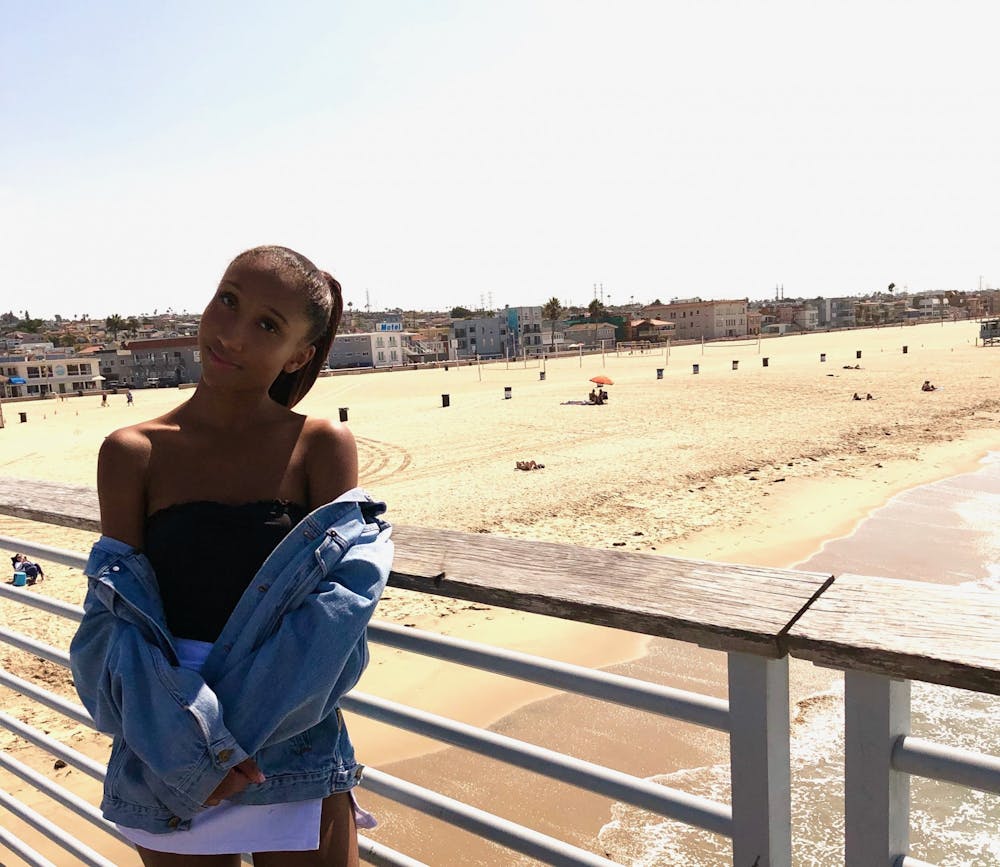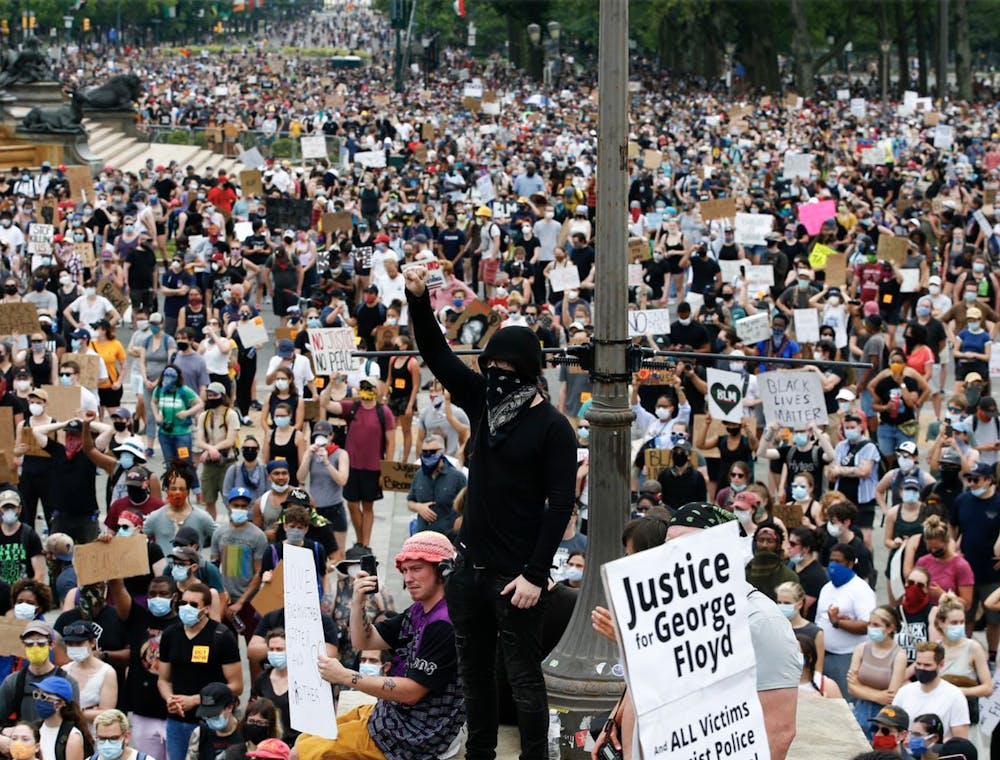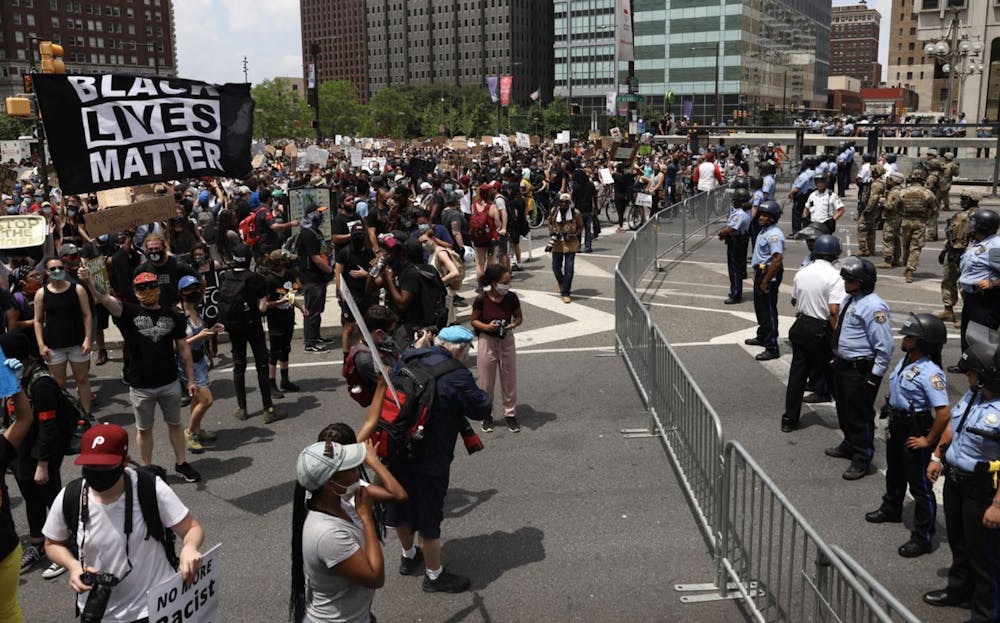On Monday morning, June 1, Lexi Lewis (C '23) left the quiet cobblestone alleys of Penn’s campus, alone. The outdoor diners and open air store fronts that usually mark early June in Philadelphia were shuttered as she passed 30th Street Station, the glittering Schuylkill River, and Rittenhouse Square. Side–by–side with Lexi, Philadelphians streamed toward City Hall, breaking the city's eerie COVID–19–era silence for the first time in months.

Lexi Lewis, C'23
People were gathering to protest persistent police brutality against Black Americans, a movement reignited by the murder of George Floyd by Minneapolis police officers Derek Chauvin, J. Alexander Kueng, Thomas Lane and Tou Thao. It was the third consecutive day of protests, and leaders encouraged the crowd to remain peaceful, noting that the police would be anticipating violence. The protesters weaved in and out of city streets, nonviolent and determined.
When they reached Interstate–676, protesters streamed onto the highway to continue their march. Police officers began to close in, and Lexi and others took a knee, chanting “hands up, don’t shoot.” Despite the call for peaceful mediation, the police began to mace kneeling protesters. They set off tear gas canisters in the front and back of the group, leaving no escape from the highway. Some made it out, hopping over the fence on the right side of the interstate. A Penn student feet away from Lexi was shot with a rubber bullet. Lexi made it to the highway’s grassy side, beginning to follow others who had hopped the fence, when police shot a tear gas canister five feet away from her. She collapsed. What followed, she describes as “10 minutes of actual, personal hell.”
“My entire body was burning. I felt like I couldn't breathe. I couldn't see. And honestly, I started to kind of resign to the fact that I was going to die.”
Lying motionless on the side of the highway, Lexi was trapped. After the onslaught of tear gas, the police rushed over, detaining Lexi and about 20 others. Time and time again, she demanded, “What am I being detained for?” A girl who was only 17 sat handcuffed beside her. For nearly 40 minutes, Lexi’s questions were ignored. Eventually, she was told she would be given a ticket for obstruction of traffic. Again, she asked, “If I’m just going to be given a ticket, why am I being detained?” The officers did not answer. Nearly 30 minutes later, police allowed Lexi and the others to go free. She walked back to Penn’s campus alone, shaken, leaving behind her glasses and the I–676 warzone.
“I had never been more shocked and more angry,” she says.

Protests like the one in Center City occurred throughout the country this past week in cities across the nation, uniting the movement across the vast distances between Manhattan, Little Rock, Arkansas, and even Anchorage, Alaska. Philadelphia’s own long and painful history of police brutality, however, gave the city’s protests a specifically poignant taste. The legacy of racist policing practices in Philadelphia can be traced back centuries, and their modern–day manifestations cemented during the mid–1900s. For Penn students like Lexi, the city’s murky history and the University’s complicated role in it remain salient. As a Black woman herself, recent protests channel an even deeper sense of obligation and reflection about being Black in America, and at Penn.
In the late 1950s, 87.5% of the people killed by Philadelphia’s majority–white police force were Black, even though Black people made up only 22% of the growing city. Illegal home raids, mass arrests, and unjust killings marked police interactions with Black people. When the notorious Frank Rizzo became police commissioner in 1967, the city’s already contentious relationship with Black and LGBTQ+ residents took a turn for the worse. Gay Philadelphians were rounded up and prosecuted. The offices of Student Nonviolent Coordinating Committee members were raided. A local student protest in favor of a Black history curriculum was violently stamped out by cops, during which Rizzo ordered the officers to “get [the students’] Black asses.” Rizzo became mayor in 1972, increasing the police budget as the city’s tax pool shrunk due to suburban flight and economic stagnation. Officers were protected from consequences under Rizzo’s watch, and countless Black Philadelphians were picked up for petty crimes.
In 1985, Philadelphia police dropped a bomb on 6221 Osage Avenue, the headquarters of MOVE, a Black liberation group, a mere 20 city blocks from Penn’s campus. Sixty–one homes were destroyed, 250 Philadelphians were left homeless, and 11 people, including five young children, were killed. The unprecedented use of military–grade violence by a local police department sent shock waves through the city. Philadelphia was dubbed “The City that Bombed Itself.” Despite the harrowing nature of this act of violence, the incident has been largely left out of American and Philadelphian historical education.
Moving into the 1990s and 2000s, national “tough–on–crime” politics pushed the city towards even stricter police governance, which continued to wear on Black and brown Philadelphia residents. A 2015 report conducted by the United States Department of Justice found that over a period of seven years, Philly cops shot civilians nearly 400 times, a rate close to that of the New York Police Department, which patrols a city five times the size of Philadelphia. Black people made up 80% of the “suspects” in officer–involved–shootings. Police shootings were investigated slowly and haphazardly, officers were poorly trained, and department policies were unclear. Today, seemingly little has changed from the Rizzo and MOVE eras.

Photo courtesy of Tim Tai / The Philadelphia Inquirer
Although Lexi was arrested on Monday, her first and more peaceful day of protesting was Saturday, May 31. City residents wore medical masks and carried homemade posters reading "I Can't Breathe" and "Justice for George." Parents marched with children on their shoulders, patrolling the city grid from up above. Young people led chants and rallied through the city, channeling anger and fear into rousing choruses. On the sides of busy streets, Philadelphians passed out water, snacks, medical supplies, masks, and gloves. Others went through the crowd to hand out packs with water bottles, bananas, and protein bars, preparing protesters for the long journey ahead.
“Someone gave me their number because they knew I was alone, in case I needed someone,” Lexi recalls.
Many moments on Saturday gave Lexi the opportunity to find power and reflection amid the aggrieved crowd. Six feet apart from the people next to her, Lexi knelt for eight minutes and 46 seconds in front of City Hall, the same amount of time Derek Chauvin kneeled on George Floyd’s neck, ultimately killing him on May 25. Together, but apart, the city silently mourned. Hushed kneeling turned slowly to chanting, with cries of “no justice, no peace” carrying through the sticky Philadelphia summer air.
After kneeling at City Hall, Lexi followed the crowd to the Philadelphia Museum of Art, and the protest grew in size. “The entire circle was covered. All of the steps were covered. I didn't expect it to be that many people, but it looked like thousands,” she says.
Although they were strangers, Lexi recalled that the scene felt comfortingly communal. The city of Philadelphia called out in one voice: “Black lives matter!”
As the crowd arrived at the Philadelphia Municipal Services Building, situated directly across from “LOVE Park,” the towering statue of Frank Rizzo, which was ultimately taken down by the city on Wednesday night, became a target. Lexi watched as some defaced the monument with spray paint, while others attempted to pull it out from the ground. An unsuccessful attempt to topple Rizzo’s bronze figure was halted when police officers once again arrived at the scene. Moving in with force, Lexi watched in horror as officers maced, tear gassed, and beat citizens. A woman she knows personally was struck with a baton and given two chipped teeth as she attempted to help another fallen protester.
“It was insane,” Lexi says. “It was entirely ridiculous the way that the cops treated us. They were trying to humiliate us…They were being rude. They were being mean,” she adds. “I didn't think that that was going to happen, especially not to a peaceful protest.”
Soon after, people began to smash windows, and set three more police vehicles on fire. Lexi’s unease crept in as she watched the city descend into chaos, however she empathized with the crowd’s frustration.
“I think it makes complete sense to be destructive after this long of everything having gone on. I think people are incredibly angry, and I don't think anybody was destructive until the police showed up.”
Lexi also experienced violence two days later—but in her case at the hands of the police, not her fellow protesters.

Lexi’s grandmother was 25 years old in 1965, when she voted for the first time. Earlier that year, Reverend Dr. Martin Luther King Jr.—arms locked with activists, students, religious leaders, and children—marched 54 miles from Selma to Montgomery, Alabama to protest persistent Black voter disenfranchisement. In 1992, Lexi’s mother watched as the city of Los Angeles burned on national television following the beating of Rodney King, an unarmed Black construction worker who was attacked brutally by police after being pulled over for a speeding violation. Nearly 30 years since the bloody Rodney King riots, Lexi found herself staring down lines of Philadelphia police officers in the middle of Interstate–676.
A Dallas native, Lexi remembers protesting against police violence for the first time in the wake of the 2016 murder of Philando Castile, a young man from Minnesota shot dead by police officer Jeronimo Yanez at a traffic stop. Feeling disheartened recently with the stagnant state of politics, Lexi was traumatized by the graphic video of George Floyd’s death.
“I can't even imagine being in that situation, being in a position literally begging for my life. It actually made me cry.”
Lexi’s experience as a Black student at Penn casts a shadow on the current wave of support Black Lives Matter has seen from the Penn community. She reflects on personal experiences with racism on campus that were met, at the time, by silence from students around her.
“You also see those same people who wouldn't punish the person who said something [racist], you know, grandstanding on social media and doing these performative things on social media for Black Lives Matter,” she says. “When the actual change starts to happen is if you actually stand up in your everyday life.”
Penn’s need for real reflection and action in addition to public messages of solidarity has circulated throughout the University community. Many feel that the University does not actually hold its students—or itself—accountable for behaviors and policies that facilitate racism.
In addition to her own experience, Lexi finds herself thinking back on Black history as a whole. “In the 1950s…we started begging people to just give us rights,” she says, “and playing these respectability politics games about trying to humanize us and trying to prove our humanity. We've been doing that for what, 70 years now? And it has not gotten us anywhere. It is honestly the most heartbreaking thing.”
“It's very overwhelming just to think about the history of this country with what they've done to me and my people” she adds. “America has taken zero accountability for it. And it's just, at a certain point, it's so, so dehumanizing.”
